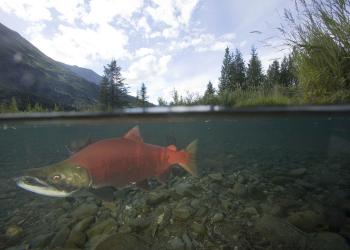Animals
Alaska's National Forests provide tremendous wildlife viewing opportunities with glaciers, complex ecosystems, diverse plant life, and rich geologic history.
Mammals
Bears of Alaska

Thousands of black bears and brown bears make their home in Alaska's National Forests. Safely seeing a bear in the wild can be the highlight of any trip.
Moose and Deer of Alaska

Moose, deer and other hooved species are found throughout southeast Alaska. Mountain goats climb along steep, rocky crags above the timberline. Sitka black-tailed deer are natives of the coastal wetlands, while elk may be found on Etolin Island.
Bats of Alaska

Southeast Alaska is home to at least five species of bats. Bats are beneficial, using echolocation to locate their insect prey.
Birds
Southeast Alaska Birding Trail

Enjoy birding through the Southeast Alaska Birding Trail, a community of birding hotspots.
Birds of Alaska

Southeast Alaska is home to over 300 bird species and draws birders from around the world. This is due to the variety of ecosystems and habitats, from temperate rainforests to marshlands. Thousands of birds pass through on their migrations, while others make their homes year-round.
Fish
Salmon

Among the most well-known fish are five species of salmon. Commercial and sport harvest of salmon help drive Alaska’s economy. They are also a very important food source for many people who call Alaska home. Salmon are an anadromous fish. This means that they spend a portion of their life cycle in both fresh and salt waters, entering fresh water from the ocean to spawn. Because salmon die after they spawn, the process results in an important transport of marine nutrients to non-marine habitats. The salmon are a major food source for many animals including bears, wolves, and eagles. Their carcasses are a source of fertilizer which helps fuel the ecology of habitats far upstream from the ocean.
Fish of Alaska

The waterways of the Tongass and the Chugach National Forests provide habitat for more than 35 species of fish.
- Alaska Department of Fish and Game Sport Fish page - Provides a wealth of information about fish, fish habitat, fishing, and fisheries management in Alaska.
- Alaska Sea Grant - Although focused on the seas, coasts and sea life of Alaska, the program provides educational materials pertinent to the Tongass and Chugach National Forests, including salmon posters and activity books and the “Alaska Seas and Rivers” curriculum.
- Fish Information Sheets - This Alaska Department of Fish and Game website provides excellent information sheets about fish, mammals and more.




